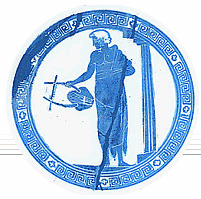Practice Test
No. 2
THE MIDDLE AGES
AND THE RENAISSANCE (476-1400) Answers
True or False
Questions:
1. Nearly a thousand
years of European history are spanned by the phrase Middle Ages.
2. Monks in monasteries held a virtual monopoly on learning
during the Middle Ages.
3. Music manuscripts
during the Middle Ages indicate that most medieval music was instrumental.
4. Gregorian chant is homophonic in texture.
5. Gregorian chant melodies tend to move by leaps over a wide
range of pitches.
6. Organum is a term applied to medieval music that consists of
Gregorian chant and an additional melodic line
7. During the Renaissance, educated people were often trained in
music, literature, theatre, and art.
8. Texture of Renaissance music is primarily homophonic.
9. Much of the instrumental dance music composed during the
Renaissance was intended for church use.
10. Troubadours were Medieval poets and musicians.
11. The 1400’s witnessed a decreased focus on secular music.
12. The Renaissance saw the growth of solo instrumental music,
especially for lute.
13. The text of a madrigal is religious and the texture is
homophonic.
14. The Renaissance madrigal was highly expressive through such
devices as word painting.
15. The Renaissance Mass was a one movement work for voices and
instruments.
16. The invention of the printing press in Western Europe was a
Renaissance development.
17. Organum was freely composed and had no pre-conceived or pre-determined
basis.
Part
Two: Fill in
18. The earliest type of polyphonic compositions, dating from
around 900 A.D., are called_____________.
19. The few surviving medieval dances and the music that
accompanied them are called_______________.
20. Hildegard of Bingen is known as:
a.
a legendary
woman minnesinger
b.
a patroness
of the troubadours
c.
a nun,
church composer, natural historian and poet
d.
the mother
of Richard the Lion-Hearted
21. Who is traditionally associated with collecting and codifying
the chants of the Church?
22. Single line melodies sung in unison from the early Christian
Church are known as_______________.
23. Which
is not true of Gregorian chant?
a.
It is
monophonic in texture
b.
It is
accompanied with harmony
c.
It is
generally non-metric
d.
It is
generally in conjunct motion
24. Medieval entertainers who played instruments, danced and
performed tricks were most likely to perform and play which genre of the
following?
a.
an estampie
b.
a Mass
c.
a madrigal
d.
Gregorian
chant
25. Wandering poets, singers and songwriters from southern France
were known as__________.
26. Music during the Medieval period music underwent a change;
developments in rhythm, meter, counterpoint and harmony took place. This became known as_____________.
27. The fretted string instrument similar to the guitar but with a
pear-shape and extremely popular during the Renaissance was the______________.
28. In the Renaissance mass, melodies move from voice to voice
imitating each other, this texture is known as____________.
29. A vocal work without instrumental accompaniment is said to be
performed_____________.
30. The expressive device used by Renaissance composers to musically
pictorialize words from a sung text is called_______________.
31. Which of the following was a leader in the Protestant
Reformation?
32. What was the primary vocal genre of secular music in the
Renaissance?
33. Which work best illustrates the technique of word painting?
a. Pope Marcellus Mass
b. Thomas Weelkes Madrigal: "As Vesta Was from Latmos Hill
Descending Descending"
c. Leonin: Organum on "Benedicamus
Domino"
d. William Byrd: Monsiers Almain
34. The polyphonic technique found in Medieval Motets, in which the
melodies change while the rhythms are repeated is called______________.
35.
What was
the most widespread of the Renaissance instrumental genres?
a.
the
madrigal
b.
dance music
c.
organ music
d.
instrumental
music to accompany voices in church
36.
The pavane
and galliard were:
a.
different
types of Renaissance chansons.
b.
forms used
in Renaissance masses.
c.
a pair of
Raissance dances in the same meter.
d.
a pair of
Renaissance dances in the contrasting duple and triple meter.
37.
Which work
was written by Bernard de Ventadorn?
a.
Plainchant
“Columba aspexit”
b.
Organum
“Alleluia”
c.
Motet
“Quant en moy”
d.
Troubadour
song “La dousa votz”
38.
Which work
was written by Hildegard of Bingen?
a.
Plainchant
“Columba aspexit
b.
Organum
“Alleluia”
c.
Motet
“Quant en moy”
d.
Troubadour
song “La dousa votz”
39.
Which work
was written by Guillaume de Machaut?
a.
Plainchant
“Columba aspexit
b.
Organum “Alleluia”
c.
Motet
“Quant en moy”
d.
Troubadour
song “La dousa votz”
40.
Which work
was written by Leonin or Perotin?
a.
Plainchant
“Columba aspexit
b.
Organum
“Alleluia”
c.
Motet
“Quant en moy”
d.
Troubadour
song “La dousa votz”
41.
Which work
was written by Josquin Desprez or Giovanni Palestrina?
a.
Mass “Pange
lingua”
b.
Lute solo
“Fantasia No. 7”
c.
Madrigal
“As Vesta was”
d.
Pavane
“Celeste giglio”
42.
Which work
was written by John Dowland?
a.
Mass “Pange
lingua”
b.
Lute solo
“Fantasia No. 7”
c.
Madrigal
“As Vesta was”
d.
Pavane
“Celeste giglio”
Answers



